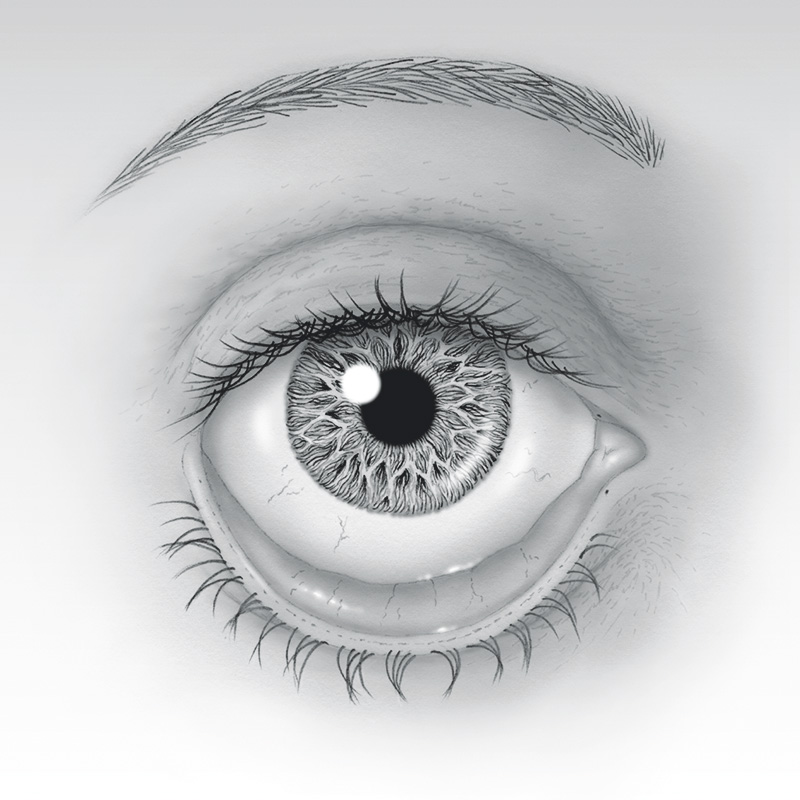 An ectropion is an outwardly turned, loose, or sagging eyelid. The lower lids are more commonly affected, but ectropion may occur in an upper lid as well. The sagging lower eyelid leaves the eye exposed and dry, and as a result, excessive tearing is common with ectropion. If it is not treated, the condition can lead to crusting of the eyelid, mucous discharge, and irritation of the eye. Serious inflammation could result in damage to the eye. Ectropion can be diagnosed with a routine eye exam. Special tests are usually not necessary.
An ectropion is an outwardly turned, loose, or sagging eyelid. The lower lids are more commonly affected, but ectropion may occur in an upper lid as well. The sagging lower eyelid leaves the eye exposed and dry, and as a result, excessive tearing is common with ectropion. If it is not treated, the condition can lead to crusting of the eyelid, mucous discharge, and irritation of the eye. Serious inflammation could result in damage to the eye. Ectropion can be diagnosed with a routine eye exam. Special tests are usually not necessary.
Generally the condition is the result of tissue relaxation with aging, although it may also occur as a result of facial nerve paralysis (Bell’s palsy), trauma, scarring, or other surgeries. Ectropion may also be associated with conditions like obstructive sleep apnea.
The wet, inner, conjunctival surface of the eyelid can flip outward, becoming exposed to the air. Normally, the upper and lower eyelids close tightly, protecting the eye from damage and preventing tear evaporation. If the edge of one eyelid turns outward, the two eyelids cannot meet properly, and tears are not spread over the eyeball. This may lead to irritation, burning, a gritty, sandy feeling, excess tearing, visible outward turning of the eyelid, and redness of the lid and conjunctiva.
Corneal dryness and irritation may lead to eye infections, corneal abrasions, or corneal ulcers. Rapidly increasing redness, pain, light sensitivity, or decreasing vision should be considered an emergency in a person with ectropion.
Treatments
The irritation can be temporarily relieved with artificial tears and ointments to lubricate the eye. Surgical treatment for an ectropion often depends on the underlying cause. In the type of ectropion associated with aging, most surgeons elect to shorten and tighten the lower lid. This typically is completed with an incision of the skin at the outside corner of the eyelid and reattachment of the eyelid to underlying tissues and the upper eyelid. Sometimes, there are scars from chronic sun exposure, following trauma, or the surgical removal of skin cancers. Your surgeon might need to use a skin graft taken from the upper eyelid or from behind the ear to repair the ectropion. Both the donor site for the graft and the surgical site will usually heal nicely within a few weeks following the surgery. The surgery to repair ectropion is usually performed as an outpatient procedure under local anesthesia, with the patient lightly sedated with oral and/or intravenous medications. You may have a patch overnight and then you will likely use an antibiotic ointment for about a week. After your eyelids heal, your eye will feel comfortable again.
Many patients experience immediate resolution of the problem once surgery is completed, with mild postoperative discomfort. After your eyelids heal, your eye will feel more comfortable and you will no longer have the risk of corneal scarring, infection, and loss of vision.
Risks and Complications
Bleeding and infection, which are potential risks with any surgical procedure, are very uncommon. Be sure to tell your surgeon if you are on blood thinners as their use may put you at increased risk for bleeding complications. In addition to the removal of the sutures, minor bruising or swelling may be expected and will likely go away in one to two weeks.
Your surgeon cannot control all the variables that may impact your final result. The goal is always to improve a patient’s condition but no guarantees or promises can be made for a successful outcome in any surgical procedure. There is always a chance you will not be satisfied with your results and/or that you will need additional treatment. As with any medical decision, there may be other inherent risks or alternatives that should be discussed with your surgeon.
Out-turned Eyelid (Ectropion) Photos • Find an ASOPRS Surgeon Near You

 An ectropion is an outwardly turned, loose, or sagging eyelid. The lower lids are more commonly affected, but ectropion may occur in an upper lid as well. The sagging lower eyelid leaves the eye exposed and dry, and as a result, excessive tearing is common with ectropion. If it is not treated, the condition can lead to crusting of the eyelid, mucous discharge, and irritation of the eye. Serious inflammation could result in damage to the eye. Ectropion can be diagnosed with a routine eye exam. Special tests are usually not necessary.
An ectropion is an outwardly turned, loose, or sagging eyelid. The lower lids are more commonly affected, but ectropion may occur in an upper lid as well. The sagging lower eyelid leaves the eye exposed and dry, and as a result, excessive tearing is common with ectropion. If it is not treated, the condition can lead to crusting of the eyelid, mucous discharge, and irritation of the eye. Serious inflammation could result in damage to the eye. Ectropion can be diagnosed with a routine eye exam. Special tests are usually not necessary.